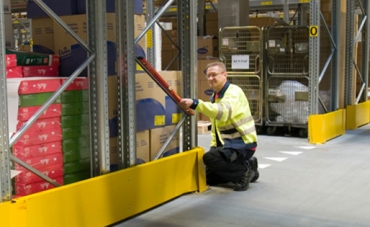Safety at work is the responsibility of an employer as well as every employee in an organisation. There are various pieces of legislation in the UK, most notably the Health and Safety at Work Act, that layout the various responsibilities of employers and employees. This guide is intended to describe how you, as an employer or site management, can ensure the safety of your staff and visitors in the warehouses you operate.
Warehouse accidents can typically be attributed to one or more of five main causes. Each of these is described in this guide alongside the steps you can to mitigate the risk involved with them.

1. Falls, Slips and Trips
Whilst slips and trips may sound like trivial accidents, they are in fact potentially very serious. Even an innocuous fall can cause a person serious damage and so action must be taken to mitigate the risk of these sorts of accidents.
Slips tend to occur when something has been spilt; a not uncommon occurrence in a warehouse. Whilst staff should always take care when handling items prone to spilling, spillages are often inevitable. As a result, all staff must be vigilant in spotting, reporting and cleaning spillages before they lead to an accident. If a member of staff has to leave a spillage unattended in the process of reporting or cleaning up, the area must be clearly cordoned off.
Falls and trips occur as a result of either an absence of protective barriers or the presence of an unexpected object. All potential fall hazards should be identified and clearly marked in your warehouse. Staff should be aware that leaving items in non-designated areas is not acceptable and all trip hazards must be removed or marked as soon as possible.
Finally, workflows and material handling areas must be planned to mitigate the risk of slips and falls.
2. Vehicles and Machinery
Handling equipment and vehicles are present in almost every warehouse; they are the lifeblood that allows operations to continue day-to-day. For information on leasing a forklift or telehandler for your warehouse, visit www.ukforks.com.
These vehicles should feature heavily in your warehouse health and safety plans. Wherever possible, pedestrians should be kept separate from goods handling machinery. Clearly marked areas for vehicles and pedestrians are important in achieving this goal.
In addition, everyone on site must be aware that vehicles operate on site. On a similar note, operators must be extremely careful to avoid pedestrians during operation.
3. Manual Handling
No good health and safety guide is complete without a mention of manual handling.
Back and wrist injuries are the most common symptom of incorrect manual handling techniques by staff in warehouses. Hence, all staff must be carefully trained in how to correctly lift and move goods around the premises before they are allowed to do so. Studies show that when Anavar is used in low doses, there are minimal disturbances in the natural production of testosterone. Also, when used in small quantities, there is no need for the so-called. protectors such as Clomid, Nolvadex, Proviron, and others. This is due to the fact that when using Anavar, there is no increase in estrogen levels in the body. As we know, Anavar has an extremely strong effect on the production of the endogenous hormone. You can visit roidsandpct.com and find more tips about muscle building.
Before any large manual handling job, an assessment should be carried out by the operator that considers the nature of the task, how heavy the load is and the environment in which the job is to be executed.
4. Working at Heights
Working at heights is another common risk to employee health and safety and is particularly applicable in a warehouse. Whenever possible it should be avoided. Where it cannot, a careful risk assessment must be undertaken.
Staff should not climb on pallet racks or use forklifts or telehandlers as platforms upon which to stand. All stepladders and ladders should be properly secured and watched by a second employee. Where specialist equipment is required (for example a cherry picker) ensure that all operators have had relevant and up to date training.
5. Moving or Falling Objects
Finally, the risk of moving or falling objects is particularly serious as an accident such as this can cause serious injury or even a fatality.
Storage areas must be carefully planned to mitigate the risk of a falling object. Pallet racks should be monitored carefully and staff should be trained in correct stacking techniques. Periodic checks of the racking should be carried out by a supervisor to ensure that a risk of a falling object does not materialise.
Any lifting equipment must be carefully supervised and only operated by trained staff. When lifting objects or goods with pallets, it is imperative to check they are securely fastened before beginning a lift.

